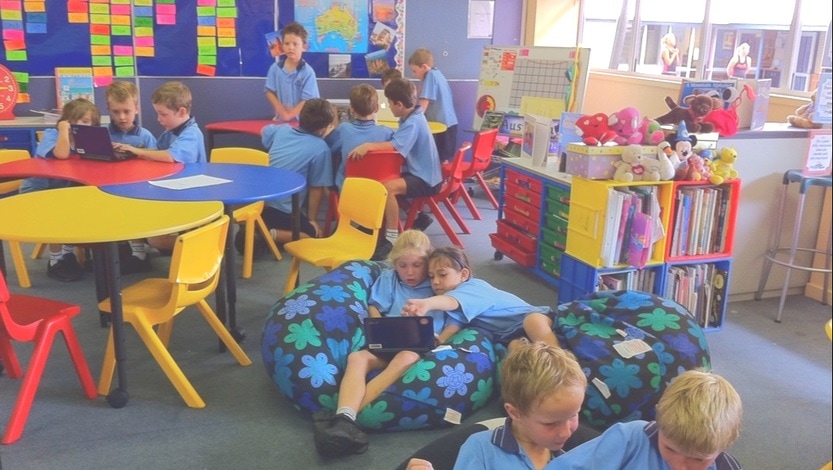|
Participation and Sensory Environment Questionnaire-Teacher Version (PSEQ-TV)
|
© 2017 Aimee Piller
|
Description: The Participation and Sensory Environment Questionnaire-Teacher Version (PSEQ-TV) was developed by a team of researchers to identify aspects of the sensory environment or sensory features of the activity that impact participation in common preschool classroom activities. This is self-report measure completed by the child’s teacher intended to guide intervention planning for occupational therapists and educators. The tool is developed for use with preschool aged children with Autism Spectrum Disorders (ASD).
The PSEQ-TV is a teacher report questionnaire designed to assess the impact of the sensory environment of children ages three to five with autism spectrum disorder in the preschool setting. The instrument provides a unique assessment to examine both the sensory environment of the preschool and participation within one instrument. The assessment is divided into three subtests: Activities, Support, and Modifications. The assessment takes approximately 10-20 minutes to complete and is available in an online format. Reliability for the assessment is good with internal consistency at 0.98 and test-retest reliability at 0.70. The assessment also has good content and construct validity.
The PSEQ-TV is a teacher report questionnaire designed to assess the impact of the sensory environment of children ages three to five with autism spectrum disorder in the preschool setting. The instrument provides a unique assessment to examine both the sensory environment of the preschool and participation within one instrument. The assessment is divided into three subtests: Activities, Support, and Modifications. The assessment takes approximately 10-20 minutes to complete and is available in an online format. Reliability for the assessment is good with internal consistency at 0.98 and test-retest reliability at 0.70. The assessment also has good content and construct validity.
RESEARCH, PUBLICATIONS, AND PRESENTATIONS:
Publications
Publications
Piller, A. (2019). Assessing the sensory environment. Sensornet, 54: 4–7.
Piller, A., Fletcher, T., Pfeiffer, B., Dunlap, K., & Pickens, N. (2018). Construct validity of the Participation and Sensory Environment Questionnaire – Teacher Version. Assessment of Effective Intervention. Early On-Line. doi: 10.1177/1534508418758363
Piller, A., Fletcher, T., Pfeiffer, B., Dunlap, K., & Pickens, N. (2017). The reliability of the Participation and Sensory Environment Questionnaire – Teacher Version. Journal of Autism and Developmental Disabilities, 47, 3561-3549.
Piller, A. & Pfeiffer, B. (2016). The sensory environment and participation of preschool children with autism spectrum disorder. OTJR: Occupation, Participation, and Health, 36(3), 103–111. doi: 10.1177/1539449216665116
Piller, A., & Pfeiffer, B. (2016). The sensory environment and participation of preschool children with Autism Spectrum Disorders. OTJR: Occupation, Participation and Health, 36, 103-111.
Piller, A. (2016). The reliability of the sensory environment and participation questionnaire Teacher version (Unpublished doctoral dissertation). Texas Woman’s University, Denton, Texas.
Piller, A. (2019). Assessing the sensory environment. Sensornet, 54: 4–7.
Piller, A., Fletcher, T., Pfeiffer, B., Dunlap, K., & Pickens, N. (2018). Construct validity of the Participation and Sensory Environment Questionnaire – Teacher Version. Assessment of Effective Intervention. Early On-Line. doi: 10.1177/1534508418758363
Piller, A., Fletcher, T., Pfeiffer, B., Dunlap, K., & Pickens, N. (2017). The reliability of the Participation and Sensory Environment Questionnaire – Teacher Version. Journal of Autism and Developmental Disabilities, 47, 3561-3549.
Piller, A. & Pfeiffer, B. (2016). The sensory environment and participation of preschool children with autism spectrum disorder. OTJR: Occupation, Participation, and Health, 36(3), 103–111. doi: 10.1177/1539449216665116
Piller, A., & Pfeiffer, B. (2016). The sensory environment and participation of preschool children with Autism Spectrum Disorders. OTJR: Occupation, Participation and Health, 36, 103-111.
Piller, A. (2016). The reliability of the sensory environment and participation questionnaire Teacher version (Unpublished doctoral dissertation). Texas Woman’s University, Denton, Texas.
Presentations
Modifying the sensory environment to support participation in the preschool classroom. Oral presentation, Arizona Occupational Therapy Association Fall Conference, Phoenix, AZ, September 24, 2018
Scientific research panel: The reliability of the participation and sensory environment questionnaire – Teacher version. Oral presentation, American Occupational Therapy Association Annual Conference, Salt Lake City, UT, April 21, 2018
The reliability of the participation and sensory environment questionnaire – Teacher version. Poster presentation, American Occupational Therapy Association, School Specialty Conference, Orlando, FL, December 1, 2017
The impact of the sensory environment on participation of preschool children with autism spectrum disorder. Poster presentation. Occupational Therapy Research Summit, Pittsburg, PA, May 21, 2016.
The reliability of the sensory environment and participation questionnaire- teacher version. Poster presentation, Texas Woman’s University Occupational Therapy Research Symposium, Texas Woman’s University, Dallas, TX, September 17, 2016.
Scientific research panel: The reliability of the participation and sensory environment questionnaire – Teacher version. Oral presentation, American Occupational Therapy Association Annual Conference, Salt Lake City, UT, April 21, 2018
The reliability of the participation and sensory environment questionnaire – Teacher version. Poster presentation, American Occupational Therapy Association, School Specialty Conference, Orlando, FL, December 1, 2017
The impact of the sensory environment on participation of preschool children with autism spectrum disorder. Poster presentation. Occupational Therapy Research Summit, Pittsburg, PA, May 21, 2016.
The reliability of the sensory environment and participation questionnaire- teacher version. Poster presentation, Texas Woman’s University Occupational Therapy Research Symposium, Texas Woman’s University, Dallas, TX, September 17, 2016.
Preliminary Psychometric Research
Initial psychometric testing of the Sensory Environment and Participation Questionnaire – Teacher Version (SEPQ–TV) indicates a valid and reliable assessment. In regards to validity, the SEPQ–TV was developed in such a method as to establish content validity. Qualitative research with participants from the target population provided the basis for question development. Thirteen preschool teachers and occupational therapists completed qualitative interview regarding perceptions on the impact of the preschool sensory environment on participation. The information from this study served as the basis for question development. Construct validity was established through cognitive interviewing of questions prior to releasing the research version. Results of cognitive interviews indicated questions were interpreted as intended. In addition, exploratory factor analysis (EFA) provided construct validity of the tool. Factors revealed by the EFA aligned with themes found in the initial qualitative study utilized to development the questions for the SEPQ–TV.
The SEPQ–TV consists of three subtests “Activities,” “Support,” and “Modifications.” One hundred and three preschool teachers completed the pilot version of the SEPQ–TV. Participants included preschool teachers from a variety of settings including public preschools, private preschools, and home-based preschools. EFA revealed six factors that accounted for 65 percent of variance. Factors included the following: Modification, Support, Preschool Tasks, Group Routines, Mealtime, and Tactile. Factor one, “Modification” and factor two “Support” aligned with the content of subtest three and two, respectively. The remaining four factors encompassed the concepts of the preschool environment and participation. These aligned with the concepts in subtest one. Cronbach’s alpha revealed an internal consistency of 0.98, indicating excellent reliability. The majority of inter-item correlations fell within the expected range of 0.30-0.70. Intraclass correlation coefficient was used to determine test-retest reliability. Results of the test-retest reliability were 0.70, which is considered good.
The SEPQ–TV consists of three subtests “Activities,” “Support,” and “Modifications.” One hundred and three preschool teachers completed the pilot version of the SEPQ–TV. Participants included preschool teachers from a variety of settings including public preschools, private preschools, and home-based preschools. EFA revealed six factors that accounted for 65 percent of variance. Factors included the following: Modification, Support, Preschool Tasks, Group Routines, Mealtime, and Tactile. Factor one, “Modification” and factor two “Support” aligned with the content of subtest three and two, respectively. The remaining four factors encompassed the concepts of the preschool environment and participation. These aligned with the concepts in subtest one. Cronbach’s alpha revealed an internal consistency of 0.98, indicating excellent reliability. The majority of inter-item correlations fell within the expected range of 0.30-0.70. Intraclass correlation coefficient was used to determine test-retest reliability. Results of the test-retest reliability were 0.70, which is considered good.
|
* Upon completion of the PSEQ-TV, you will receive an email with your scores. A de-identified version of your responses will be used as part of a larger research study to further develop and refine the measurement tool.
|
Please be advised that these are clinical research versions of the PSEQ, PSEQ-TV and PES that will be constantly updated and revised as we learn from them.
|
Clinicians, feel free to use this information in any way that you feel it will benefit your practice and your clients' understanding their child's responses to the Sensory Environment .
|
HOME PSEQ PSEQ - Teacher Version Parent Effort Scale Research Team Contact
© 2017 Beth Pfeiffer, all rights reserved


